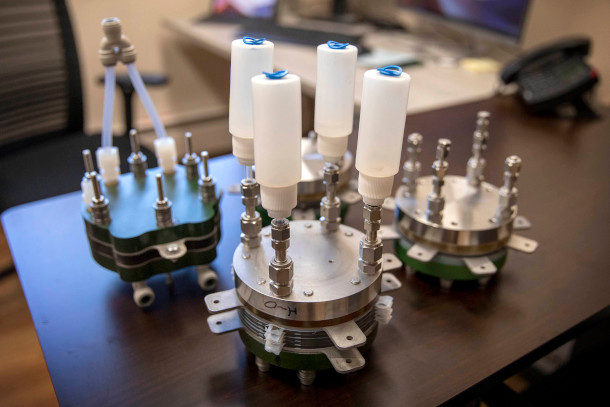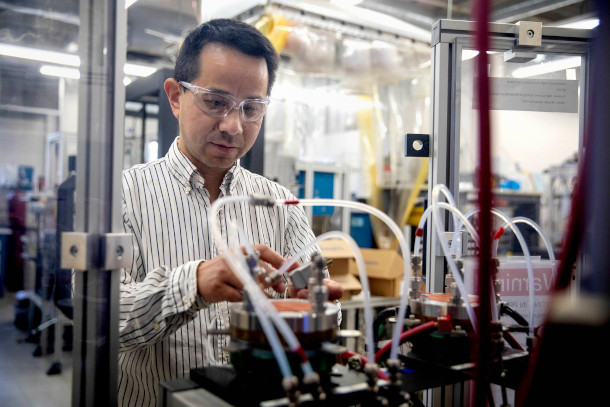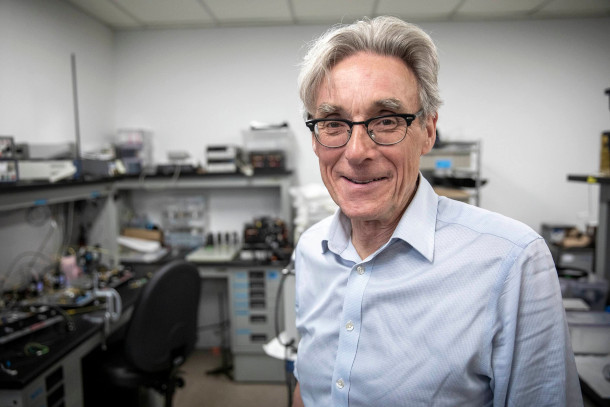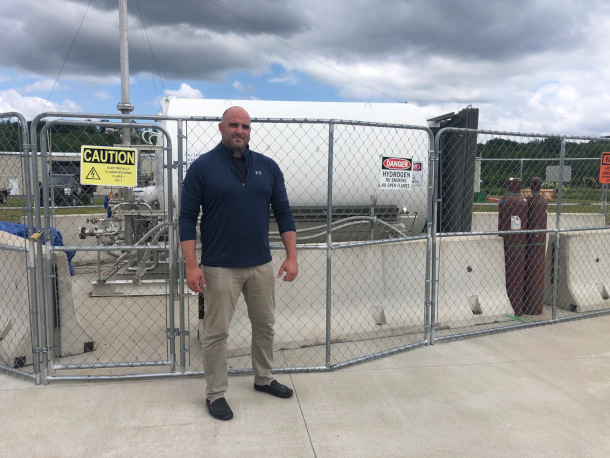Hydrogen Fueled Future
Air Date: Week of September 8, 2023

These electrolysers from Giner, Inc split the bonds of water to produce hydrogen and oxygen. (Photo: Robin Lubbock, WBUR)
If you combine hydrogen from carbon-free sources and oxygen in a fuel cell, you get water and electricity. Bruce Gellerman reports on how this chemical reaction is fueling visions of future, carbon free flights and changing voyages of fantasy into reality.
Transcript
DOERING: Ok Paloma, in honor of the start of the school year, you ready for a pop quiz?
BELTRAN: [nervous laugh] oh-oh kay??...
DOERING: How much do you remember from gen chem?
BELTRAN: Oof, I wasn’t a big fan of chem…
DOERING: Me neither, truth be told but maybe you remember the atomic number of Hydrogen?
BELTRAN: Let me see… hmm… would that be… number 1?
DOERING: Yep! That’s an A+
Hydrogen is Atomic Number 1 on the periodic table because it’s the smallest, lightest element in the universe. It’s also by far the most abundant, making up about three-quarters of all matter. And if you combine hydrogen and oxygen in a fuel cell, you get water and clean, green electricity [Editor's Note: that's true if the hydrogen was derived using carbon-free energy]. This chemical reaction is fueling visions of future, carbon-free flights and voyages of fantasy that could soon become reality. Our friend Bruce Gellerman first produced this story for WBUR-Boston.
GELLERMAN: 150 years ago, Jules Verne captured the world's imagination with his science fiction novel, “Mysterious Island”, continuing the journey of the Nautilus submarine.
CAPTAIN NEMO: I'm Captain Nemo. Welcome to my island.
[“MYSTERIOUS ISLAND” MUSIC]
GELLERMAN: Verne wrote that "water will one day be employed as fuel," that the separated elements, hydrogen and oxygen, quote, "will furnish an inexhaustible source of heat and light, of an intensity of which coal is not capable.” Pure hydrogen is a powerful energy source and it is the most abundant element in the universe. And over the decades, the dream of harnessing hydrogen to transform the world's economy has persisted in the hearts and minds of scientists and politicians.
SOVACOOL: And the term in the communications studies literature and psychology is, "they came to a symbolic convergence.”
GELLERMAN: Benjamin Sovacool, Director of Boston University's Institute for Sustainable Energy, is author of the book: "Visions of Energy Futures.”
SOVACOOL: Symbols, ideology, values and language all coalesced around this miraculous vision of what a hydrogen economy would do, and the fantasy itself was very very real, and it was very effective at shaping funding patterns, and at shaping even scientific discourse.
GELLERMAN: Sovacool recalls President George W Bush's 2003 State of the Union Address.
BUSH: Tonight I am proposing 1.2 billion in research funding, so that America can lead the world in developing clean hydrogen-powered automobiles.
[APPLAUSE SFX]
SOVACOOL: Whenever anyone talks about a hydrogen economy, they’ll usually say things like, "well, and its only output is water."
[APPLAUSE SFX]
BUSH: A simple chemical reaction between hydrogen and oxygen generates energy, which can be used to power a car, producing only water, not exhaust fumes.

While most of the hydrogen produced today uses fossil fuels, green hydrogen uses renewable energy sources. (Photo: Robin Lubbock, WBUR)
GELLERMAN: Chances are you're not driving a hydrogen-powered car, at least not yet.
There are several good reasons. On earth, most hydrogen is chemically bonded to oxygen to form water or to carbon to make fossil fuels. And the procedure most often used emits a lot of climate disrupting gases. Sovacool says scientists have color-coded hydrogen according to the kinds of energy used in the separation process.
SOVACOOL: So there’s gray and black, which is fossil fuel, there’s blue which comes from natural gas, there’s green which comes from renewables, and there’s pink which comes from nuclear power.
GELLERMAN: Today, most of the hydrogen we separate today is black. Green is the kind you want, using electricity generated by renewable solar and wind power. But until recently, it wasn't practical or profitable to make large amounts of green hydrogen.
Scientists at the Massachusetts-based R&D company, Giner Inc, have been working at it for 50 years.
BELT: We operate at the frontiers of electrochemical technologies, pushing the envelope. We're actually the best in the world at that.
GELLERMAN: Andy Belt is Giner's CEO. He says the company has been perfecting the technology to split water efficiently. It's a process known as electrolysis. It's done in a device called an electrolyser.
BELT: In the guts of the electrolyser, where the magic happens, you combine water with electricity, and you break the bonds of water and out comes hydrogen and oxygen. And that's the magic that goes on in the center of an electrolyser.
GELLERMAN: Inside the devices are thin membranes, coated with precious metals. They enable the electrochemistry magic to work. Low cost wind and solar electricity make the process green.
BELT: Because of advances in renewable energy, because of the advances in electrolysis technologies, it’s absolutely feasible to see that within 10 years that we could have a massive piece of the energy infrastructure based on green hydrogen.

Andy Belt, CEO of Giner, Inc, says that the cost of producing green hydrogen is declining. (Photo: Robin Lubbock, WBUR)
GELLERMAN: Belt says producing green hydrogen is becoming more cost effective as the price of generating electricity from solar and wind declines. Today, in many places the renewable energies are cheaper than burning natural gas and coal.
BELT: So if I can buy electricity at 2 cents per kilowatt hour and make hydrogen with my electrolyzer, the cost of electricity to make a kilogram of hydrogen is now a buck or less.
GELLERMAN: And that's one of the Department of Energy's goals. Cut the cost of separating hydrogen by 80 percent in a decade. It would make the price of energy from hydrogen equal to gas selling at about a dollar a gallon. Boston University's Benjamin Sovacool says that price doesn’t even consider the hidden costs of burning fossil fuels on the climate and human health.
SOVACOOL: You start pricing coal accurately, hydrogen’s much more competitive. You start pricing things like oil more competitively, hydrogen and renewables are more competitive. Energy’s cost does not match its price.
GELLERMAN: Sovacool still has doubts about the future of a green hydrogen economy, but he's cautiously hopeful the proposed federal hydrogen hub program could work.
SOVACOOL: I'm slightly skeptical, but I think there's a lot more rationality for hydrogen here. If the government were to continue to create the right policy architecture, hydrogen transitions could very much occur in the next 10 or 15 years. They won't happen by themselves in the market, but if they had the right sort of incentives and policy, I could see it happening.

Bill Spellane is Chief Operating Officer of Alakai Technologies, a company hoping to make hydrogen-powered air travel a reality. (Photo: Bruce Gellerman, WBUR)
GELLERMAN: It’s already happening in Massachusetts, where engineers with Alakai Technology are unlocking hydrogen’s power.
[HANGER SFX]
GELLERMAN: In a large hanger at Minute Man Air Field in Stow, Mass workers are assembling prototypes of clean green, flying machines unlike any that have flown before.
SPELLANE: So we’re building a hexacopter that will fly up to 400 miles, a thousand pounds of people or cargo, we’re hydrogen powered, not battery powered. We do hydrogen.
GELLERMAN: Bill Spellane is Chief Operating Officer of Alakai Technologies. He's standing under one of the six rotor blades of the company's Skai aircraft, spelled S-K-A-I. The hydrogen-electric hexicopter looks like a futuristic minivan that can take off and land vertically.
Aboard SKAI will be cyclinders filled with liquid hydrogen that's warmed to a gas and pumped into fuel cells, where the hydrogen will combine with oxygen from the atmosphere, producing H2O and electricity.
There are no fossil fuels, no climate disrupting emissions.
SPELLANE: Hydrogen plus oxygen equals water and energy. We use the energy, expel the water. That’s our emissions, water.
GELLERMAN: That’s it?
SPELLANE: That’s it, water.
GELLERMAN: Hydrogen packs a powerful energy punch, pound for pound, gallon for gallon. Three times more energy than jet fuel. And refueling takes just a few minutes.
SPELLANE: For an aviation application, hydrogen is compelling. You need to store a lot of fuel in order to fly a vehicle. Hydrogen provides that to you. We have fewer moving parts, the vehicle is simple to operate, simple to maintain. You don’t have to pay as much in maintenance.
GELLERMAN: Spellane says the hexacopter is stable in high winds, has room for a pilot and 4 passengers, can be used for air taxi and cargo services, medical flights, and disaster relief. Top speed? 115 miles per hour. Rotors mounted on the 6 arms, stretch skyward, each powered by an electric engine.
SPELLANE: If you want to tilt forward, the rotors in the back speed up, the ones in the front speed down, your attitude changes, and now you can fly forward. If you want to go right, you speed up the left side, turn down the right side, you roll right.
[RADIATOR FAN SFX]
GELLERMAN: Technicians test a radiator fan aboard one of three SKAI prototypes. Today 50 engineers, many ex-military aviators and engineers, work at Alakai.
Bill Spellane, speaking with an understated passion, says he’s worked 7 days a week for the last 5 years.

Alakai Technologies’ hexacopter is powered by hydrogen fuel cells, which emit only water. (Photo: Tamara Willsie)
SPELLANE: This is the second vehicle ever built, R&D vehicle. Pure iron bird test vehicle.
GELLERMAN: Do you have a name for it?
SPELLANE: We call it Prototype 0.5.
GELLERMAN: No endearing term, no like Bluebird 7, or something like that, or Hydro 3?
SPELLANE: We are engineers, sir. Prototype 2.
GELLERMAN: Spellane hopes a public demonstration of the hydrogen-powered hexicopter takes place soon. Then, he predicts, things are going to take off. But actually, hydrogen fuel cells have been around for 60 years, when a breakthrough launched the technology into orbit, literally.
BELT: And that was a technology developed by GE in Lynn, Massachusetts, for the Gemini space program..
GELLERMAN: Andy Belt, head of the hydrogen research company Giner, says back then, General Electric engineered fuel cells that were reliable, powerful and safe for space, and beyond.
BELT: That was extraordinarily exciting. Fuel cells, hydrogen, were going to be the future of not just of space travel, but transportation in general.
GELLERMAN: But so far hydrogen hasn't fueled our general transportation needs. It may be the most abundant element in the universe, but isolating hydrogen has been expensive and climate disruptive. Clean renewable sources of electricity could change the equation. Large solar and wind projects may make it possible to power electrolysis to split water and produce green hydrogen on an industrial scale. Judith Lattimer, a senior project scientist at Giner, looks to the horizon for a way to make hydrogen low cost and climate friendly.
LATTIMER: What we’re working on is to couple offshore wind turbines directly with electrolyzers, in order to produce hydrogen offshore for fueling ships, or you can use a pipeline to get it on shore.
GELLERMAN: Either way would be a sea change. In fact, “Sea Change “ is the name of a green hydrogen powered ship now being tested in Puget Sound, Washington State.
RATTI: We are turning hydrogen into electrons, into electricity, through a fuel cell, without the carbon, which is kind of incredible.
GELLERMAN: Pace Ratti is founder and CEO of Switch Maritime, developer of Sea Change. He says the 70 foot vessel, powered by hydrogen fuel cells, will soon start ferrying passengers across San Francisco Bay. Ratti has spoken with other seafaring companies. He won’t discuss specific deals, but suggests they're in the works here.
RATTI: There’s going to be a lot of exciting projects on the east coast.
GELLERMAN: The green hydrogen economy, powered by solar and wind energy, is picking up speed as a replacement for fossil fuels. And Pace Ratti says the developments haven’t gone unnoticed.
RATTI: Traditional oil and gas companies are trying getting into this game as well, you know, seeing hydrogen as the next commodity they want to be selling in addition to or in place of oil and gas.
[CHEVRON ADVERTISEMENT MUSIC]
CHEVRON:What lies on the horizon, the answers lie beyond the roads we know.
GELLERMAN:Chevron oil advertised its hydrogen hopes on air.
CHEVRON: We recognize that energy demand is growing and the world needs lower carbon solutions to keep up.

The hexacopter can fly at up to 115 miles per hour while carrying a pilot and four passengers. (Photo: Robin Lubbock, WBUR)
GELLERMAN: Chevron, ExxonMobil, and Shell Oil have joined forces with other energy interests to develop a large-scale hydrogen hub along the US Gulf Coast.
They are competing for a chunk of the 9.5 billion dollars in hydrogen funding set aside in the federal Bipartisan Infrastructure Law. But while big oil has big plans, building a green hydrogen economy will require tens upon thousands of small companies developing innovative products like the ship Sea Change and Alakai’s SKAI hexacopter.
[HEXICOPTER SFX]
GELLERMAN: The unique flying machine is now going through the F-A-A certification process. Watching is company COO Bill Spellane, who stands in a field as a test pilot puts the hydrogen powered vehicle through its paces.
SPELLANE: It’s quieter than a helicopter, it’s quieter than a turbine aircraft. It’s quieter than the piston aircraft that also take off at this airport. Is it something you can sleep under? No, but you be the judge of how loud it is.
[HEXICOPTER SFX]
GELLERMAN: And slowly, surely, the hydrogen powered hexacopter lifts off the ground.
For a century and a half, the green hydrogen economy has been predicted by novelists, researched by scientists, and hyped by politicians. But as the global climate crisis worsens, the technology advances. China, Saudi Arabia and Brazil are among the countries investing billions to produce green hydrogen, their ambitions generating real hope for a future imagined long ago by science fiction writer Jules Verne.
[MUSIC]
GELLERMAN: For Living on Earth, I’m Bruce Gellerman.
Links
WBUR | “Moving Hydrogen from Hype to Hope”
WBUR | “Freeing—and Capturing—Hydrogen in Mass.”
Living on Earth wants to hear from you!
Living on Earth
62 Calef Highway, Suite 212
Lee, NH 03861
Telephone: 617-287-4121
E-mail: comments@loe.org
Newsletter [Click here]
Donate to Living on Earth!
Living on Earth is an independent media program and relies entirely on contributions from listeners and institutions supporting public service. Please donate now to preserve an independent environmental voice.
NewsletterLiving on Earth offers a weekly delivery of the show's rundown to your mailbox. Sign up for our newsletter today!
 Sailors For The Sea: Be the change you want to sea.
Sailors For The Sea: Be the change you want to sea.
 The Grantham Foundation for the Protection of the Environment: Committed to protecting and improving the health of the global environment.
The Grantham Foundation for the Protection of the Environment: Committed to protecting and improving the health of the global environment.
 Contribute to Living on Earth and receive, as our gift to you, an archival print of one of Mark Seth Lender's extraordinary wildlife photographs. Follow the link to see Mark's current collection of photographs.
Contribute to Living on Earth and receive, as our gift to you, an archival print of one of Mark Seth Lender's extraordinary wildlife photographs. Follow the link to see Mark's current collection of photographs.
 Buy a signed copy of Mark Seth Lender's book Smeagull the Seagull & support Living on Earth
Buy a signed copy of Mark Seth Lender's book Smeagull the Seagull & support Living on Earth

